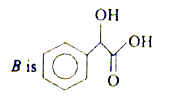An ester 'A' (C4H8O2) on treatment with excess methyl magnesium chloride followed on acidification gives an alcohol 'B' as the sole organic product. Alochol 'B' as the organic product. Alcohol 'B' on oxidation with NaOCl followed by acidification gives acetic acid. Deduce structure of A and B. Show the reactions involved.
(i) Since alcohol (B) on oxidation with NaOCl haloform reaction ) followed by acidification gives acetic acid thus it can be either ethyl alcohol or 2-propanol.

(ii) Since alcohol (B) is obtained by addtion of excess of CH3MgCl, on ester (A), therefore the alcohol both the methyl group because esters and two molecules of the Grignard reagent that is its (CH - OH) part has come form acid part of ester . Thus (A) must be fomic ester .
(iv) Since molecular formula of ester (A) is C4H4O2, therefore alkyl group of ester must contain three carbon atoms either n - propyl group or isopropyl group.
(v) Further , since 2 - propanol (B) is the sole organic product obtained when two molecules of (CH3)3MgCl are added to ester (A). Therefore , the alkyl group of ester (A) must be isopropyl group.
Thus , ester is isopropyl formate . 
Similar Questions
Knowledge Check
Compound (A) C8H6O2 on treatment with aq. NaOH followed by acidification gives (B) C3H2O3 which on oxidation gives benzoic acid only:
A B
B C
C D
D
How many isomar of C4H8O when react with CH3MgBr followed by acidification to give 2∘ alcohol?
View SolutionGive the majore and minor products of the following reactions.
a.
b.
View SolutionA compounds X is fromed by the reaction of a carboxylic acid C2H4O2 and an alcohol in the presence of a few drops of H2SO4. The alcohol on oxidation with alkalne KMnO4 followed by acidification gives the same carboxylic as used in this reaction. Give the names and structures of (a) carboxylic acid, (b) alcohol and (c ) the compound X. Also write the reaction.
View SolutionAn optically active alcohol A (C6H10O) absorbs 2 mol of hydrogen per mole of A upon catalytic hydrogenation and gives a product B. The compound B is resistant to oxidation by CrO3 and does not show any optical activity Deduce the structures of A and B.
View SolutionA compound [A] has the formula C4H8O2. When reacted with a Grignard reagent, CH3MgBr, it takes up two molecules of it and upon acidification gives an alcohol [B]. The alcohol on reacting with Lucas reagent gives white coludiness on standing for sometime. When the alochol is oxidised, a compound [C] is produced with a pleasant smell. It neither reacts with Tollen's reagent, nor with Fehling's reagent.
The alcohol [B] is
View SolutionA compound [A] has the formula C4H8O2. When reacted with a Grignard reagent, CH3MgBr, it takes up two molecules of it and upon acidification gives an alcohol [B]. The alcohol on reacting with Lucas reagent gives white coludiness on standing for sometime. When the alochol is oxidised, a compound [C] is produced with a pleasant smell. It neither reacts with Tollen's reagent, nor with Fehling's reagent.
The compound [A] is
View SolutionA compound [A] has the formula C4H8O2. When reacted with a Grignard reagent, CH3MgBr, it takes up two molecules of it and upon acidification gives an alcohol [B]. The alcohol on reacting with Lucas reagent gives white coludiness on standing for sometime. When the alochol is oxidised, a compound [C] is produced with a pleasant smell. It neither reacts with Tollen's reagent, nor with Fehling's reagent.
The compound [A] is
View Solution

